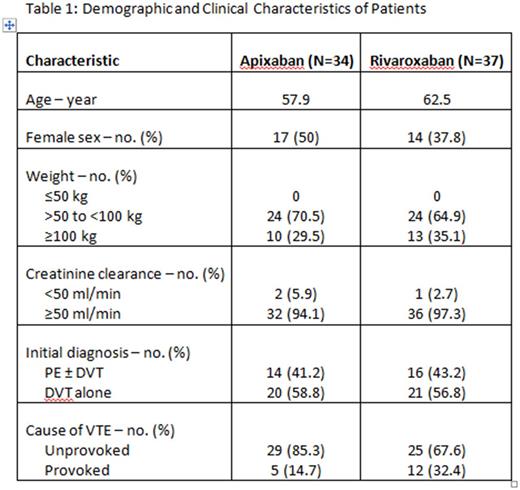Abstract
Introduction: The direct oral anticoagulants (DOACs) apixaban and rivaroxaban have simplified the treatment of acute venous thromboembolism (VTE). Phase III randomized controlled trials demonstrated each DOAC to have similar or better safety and efficacy profiles to vitamin K antagonists, while network meta-analyses suggest that apixaban might be associated with fewer bleeding events than rivaroxaban. Trial limitations and lack of direct comparison between these agents make it impossible to know which DOAC confers the best risk-benefit ratio. The COBRRA (COmparison of Bleeding Risk between Rivaroxaban and Apixaban) pilot feasibility study (NCT02559856) was designed to determine if it is feasible to conduct a large randomized multicenter trial comparing apixaban to rivaroxaban for the treatment of acute VTE.
Methods: Adult patients with symptomatic acute VTE were eligible for randomization to apixaban or rivaroxaban in an open-label fashion. The exclusion criteria were: had received >72 hours of therapeutic anticoagulation; creatinine clearance <30 ml/min; another indication for long term anticoagulation; weight >120 Kg; known Child-Pugh B or C liver disease; active bleeding; active malignancy; pregnancy/breastfeeding; and use of contraindicated medications. Patients were followed on anticoagulation for 3 or 6 months.
The pilot trial was conducted in 4 Canadian centers that are part of the CanVECTOR network. Two sites are established Thrombosis research centers and the other 2 sites are emerging research centers with minimal established research infrastructure. The primary outcome was recruitment of at least 2 patients per month per site over a mean of 6 months recruitment. Secondary outcomes included major bleeding, clinically relevant non-major bleeding, and minor bleeding events; recurrent VTE; VTE related deaths; and all-cause mortality.
Results: Seventy-two patients were enrolled with mean recruitment of 4 patients per month at experienced sites and 2 patients per month at new sites. Baseline clinical characteristics are available in Table 1. Thirty-four patients were randomized to apixaban with mean age 58 years; 37 patients were randomized to rivaroxaban and had mean age of 63 years.
Follow up visits are ongoing at three participating sites and results will be available in October 2017. No patients have been lost to follow up.
Conclusions: This pilot trial is the first direct comparison of rivaroxaban and apixaban for acute VTE treatment. Recruitment targets were met hence we demonstrated feasibility of the main trial. The sample size of the full study is estimated to be 2760 patients. With recruitment rates similar to those observed in this pilot study, we would need at least 10 experienced centers and 8 emerging sites to ensure enrolment is completed over 4 years. Secondary outcome reporting will be available for the 59th ASH Annual Meeting.
Castellucci: BMS: Honoraria; Bayer: Honoraria; Leo Pharma: Honoraria; Boehringer-Ingelheim: Honoraria; Pfizer: Honoraria. Le Gal: Bayer: Honoraria; BMS: Honoraria.
Author notes
Asterisk with author names denotes non-ASH members.


